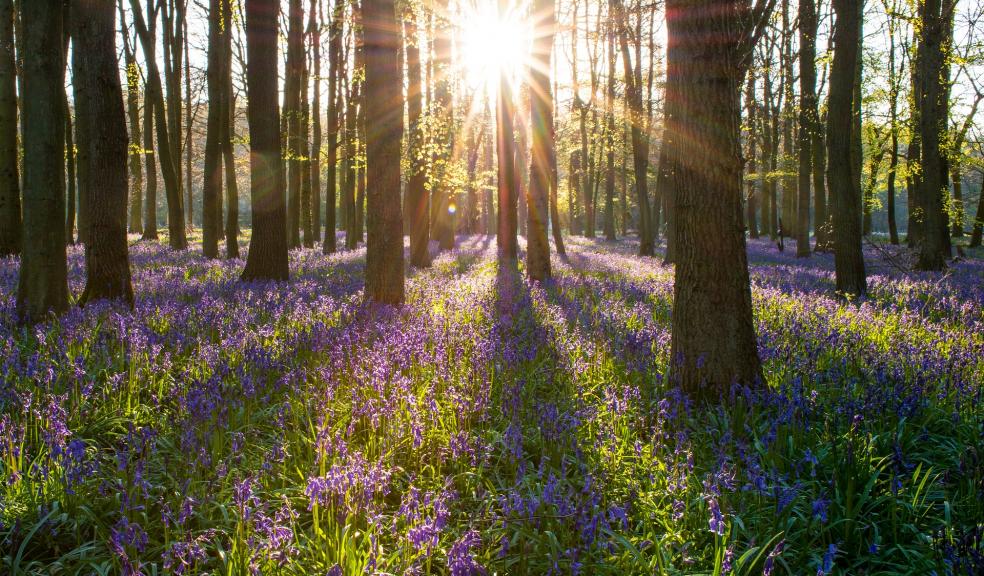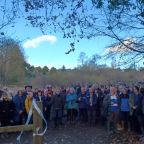
Best places to see bluebells in the SW
Visiting a Bluebell Wood is one of the UK’s great seasonal highlights and the Woodland Trust has lots for you to visit for free across the South West this spring.
When bluebells first appear can vary depending on early spring temperatures, so when you see your first bluebells you can record them on the Trust’s Big Bluebell Watch survey to help track their arrival across the country. There is a fear that non-native Spanish bluebells are cross-breeding with our English bluebells. Learn how to tell the difference: https://www.woodlandtrust.org.uk/visiting-woods/bluebell-watch-recording/
An enchanting carpet of native bluebells is a great indicator of ancient woodland, which is one of our rarest and most irreplaceable habitats, covering just 2% of the country’s landmass. It’s hugely important to look after the flora and fauna within, so the charity is asking visitors to bluebell woods to stick to marked trails and avoid trampling bluebells so they can be preserved in both the short and long term.
The walks are suitable for all ages and well behaved dogs on lead are welcome. Booking is not required.
Some of the best South West bluebell woods
1. Duncliffe Wood, Stour Row, Shaftesbury
It is said that this beautiful ancient woodland inspired Thomas Hardy to write The Woodlanders. It’s certainly a wonderful place to visit: rich in wildlife, steeped in history, full of notable plant species and a good mix of native broadleaves and conifers, with ancient coppice stools said to be the oldest living things in Dorset.
https://www.woodlandtrust.org.uk/visiting-woods/wood/?woodId=4136&woodNa...
2. Hardwick Wood, Plympton, Plymouth
This ancient woodland site is dominated by broadleaf trees. In spring, enjoy a superb show of not just bluebells, but also ransom and campion flowers. A network of green rides and narrow paths crisscross the site, providing a variety of routes to explore.
https://www.woodlandtrust.org.uk/visiting-woods/wood/?woodId=4022&woodNa...
3. Whitleigh Wood, Tamerton Foliot, Plymouth
This ancient woodland is an oasis of calm right on Plymouth’s doorstep. You can stroll along its accessible paths through refreshing greenery, enjoy the changing colours of the seasons, from spring bluebells to the blazing hues of autumn, and spot wildlife, including roe deer, foxes and buzzards. A visit to Whitleigh Wood is the perfect antidote to city life.
https://www.woodlandtrust.org.uk/visiting-woods/wood/?woodId=4082&woodNa...
4. Greyfield Wood, High Littleton
This mix of ancient woodland and newer planting was once part of the Earl of Warwick’s hunting estate. Its wide range of broadleaf species, wonderful wildlife, enchanting waterfall, and extensive path network makes Greyfield Wood a delight to visit at any time of year.https://www.woodlandtrust.org.uk/visiting-woods/wood/?woodId=4797&woodNa...
5. Towerhouse Wood, Nailsea
Towerhouse Wood is an attractive woodland, bounded on one side by a stream featuring an unusual pond with gas bubbling through the water. Access is directly from Towerhouse Lane and several well used paths circle through the wood.
https://www.woodlandtrust.org.uk/visiting-woods/wood/?woodId=4508&woodNa...
6. Dolebury Warren, Churchill
Dolebury Warren lies on the north scarp of the Mendips within the Mendip Hills Area of Outstanding Natural Beauty. It is part of continuous woodland stretching for many miles along the slope.
https://www.woodlandtrust.org.uk/visiting-woods/wood/4177/dolebury-warren/
7. The Plantation and Bluebell Field, Uphill, Weston-super-Mare
The Plantation and Bluebell Field is a 19th century plantation of predominantly beech well known for its display of bulbs, particularly bluebells in springtime. The main entrance to the wood is through a squeeze point off Uphill Road North.
8. Adcombe Wood, Blagdon, Blackdown Hills
Overlooking Taunton Vale in the Blackdown Hills area of Outstanding Natural Beauty and part of a Site of Special Scientific Interest, Adcombe has spectacular views and is full of spring colour. Note that some of the extensive network of paths and rides are very steep and may be wet and uneven underfoot. https://www.woodlandtrust.org.uk/visiting-woods/wood/?woodId=4392&woodNa...
9. Two Mile Coppice , Broadwey, Weymouth
Two Mile Coppice consists of mainly ash, oak and hazel. The main access is via a bridleway from Greenway Road large enough to allow pushchairs and wheelchairs. Within the wood there is a circular loop path with a natural earth surface.
https://www.woodlandtrust.org.uk/visiting-woods/wood/4811/two-mile-coppice/
10. Prescott Pinetum, Uplyme, Lyme Regis
Hosting a variety of majestic oak, beech and conifer species, overlooking Lyme Regis and the Jurassic Coast, the Pinetum is thought to have been established between 1840 and 1860s, and features giant Wellingtonia's, Grand fir, Noble Fir, Blue Atlas Cedar, Japanese Red Cedar, Prince Albert's Yew and Coast Redwoods. Many of the conifers that remain are now magnificent specimen trees, including one UK champion. This site's diversity of species has earned it a Tree Preservation Order. A single path meanders through the woodland. Look out for the remains of a woodman's cottage.
https://www.woodlandtrust.org.uk/visiting-woods/wood/4024/prescott-pinetum/
11. Clanger Wood, Westbury, Wiltshire
Beautiful Clanger Wood has an impressive pedigree – it has been woodland since at least 1086, and probably longer. As an ancient wood it’s a jewel for nature-lovers; somewhere to hear the deep, rich song of the nightingale, to breathe in the heady scent of bluebells in bloom and to spot rare butterflies.
https://www.woodlandtrust.org.uk/visiting-woods/wood/?woodId=4114&woodNa...











